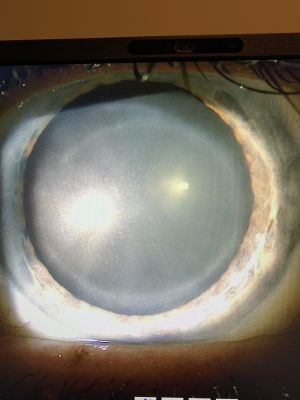Ascher Ring
All content on Eyewiki is protected by copyright law and the Terms of Service. This content may not be reproduced, copied, or put into any artificial intelligence program, including large language and generative AI models, without permission from the Academy.
Disease Entity
Disease
Only a handful of cases have been reported. It was first described by Dr Ascher in Germany in 1964. [1]He reported a case of bilateral 7mm anterior stromal rings in a 39 year old patient with a history of unilateral iritis. There have been other rare case reports over the years of similar bilateral rings. In 1998, Melles et al described bilateral midperipheral ring opacities in a healthy 25 year old patient. The authors described in their paper 6 other patients previously reported in the literature with similar rings.[2] More recently, Megalla et al [3]described a 70 year old man with bilateral 7mm round stromal rings. The rings are asymptomatic and do not progress. There are no associated inheritance patterns or systemic pathologies; they are considered a diagnosis of exclusion. They do not require treatment.
Etiology
Initially, these opacifications were believed to be a result of an immunologic reaction (similar to Wessely immune rings) as some patients with this entity had ocular histories of unilateral idiopathic iritis or marginal infiltrates. However, newer considerations suggest that the opacities may be extracellular material likely deposited along a centripetal gradient.[3]
Diagnosis
Examination
On slit lamp examination, intrastromal (of varying depths) mid-peripheral symmetric bilateral corneal rings are observed. The photos in Melles's 1998 article portray a large narrow stromal ring opacity in the midperipheral cornea that appears similar to the outline of a LASIK flap.[2] The photos in Megalla's 2021 case report show a slightly thicker, hazy 7mm stromal ring. Khan and Shuttleworth [4]offer a detailed description of their patient:
"Bilateral, thin (<0.5 mm), grey-white, granular but continuous, mid-peripheral stromal corneal ring opacities were incidentally noted. The rings were 7–8 mm diameter and in cross section were “V”-shaped: widest nearest to Descemet’s membrane. The apex, anteriorly, was slightly displaced towards the centre of the cornea. The central and peripheral cornea was clear. "
Imaging
Corneal stromal opacification is visualized on OCT. Confocal microscopy shows reflective extracellular deposits.
Management
Prognosis
The prognosis is very good for Ascher rings. They do not appear to be visually significant, and no treatment is indicated.
References
- ↑ Ascher, K. An Unusual Corneal Ring. Ber Zusammenkunft Dtsch Ophthalmol Ges. 1964; 65: 44-46.
- ↑ Jump up to: 2.0 2.1 Melles, G., de Sera, J., Eggink, C., et al. Bilateral anterior stromal ring opacity of the cornea. B J Ophthal. 1998; 82: 522-525.
- ↑ Jump up to: 3.0 3.1 M Megalla, E Li, P Branden, J Chow, "Bilateral idiopathic corneal opacity: A report of Ascher ring and a review of the literature," Am J Ophthalmol Case Rep, 2021 Sep; 23: 101176.
- ↑ Khan JC, Shuttleworth GN. Annular granular corneal opacity: a rare corneal stromal dystrophy or degeneration? Br J Ophthalmol. 2000;84(10):1205-6.
- Reiger, G. Primare, einseitige, ringförmige Trübung der Hornhaut. Fortschr Ophthalmol. 1987; 84: 242-244.
- Rohrbach, J., Kleiser, N., Kaufmann-Fechner, J., Lish, W. Corneal ring opacity (Ascher ring)- a case report. Klin Monbl Augenheilkd. 2001; 218(4): 276-278.
- Silvestri, A., Boisjoly, H. Bilateral Corneal Ring Opacity of Unknown Origin. Cornea. 2003; 22(1): 86-87.
- Moshirfar, M. Corneal Surgical Problem. J Cataract Refract Surg. 2015; 41: 895-896.
- Bron, A. Peripheral ring opacity of the cornea. Brit J Ophthal. 1969; 53:270-273.
- Bopp, S., Laqua, H. Corneal Ascher ring. A ring-shaped stromal corneal opacity. Klin Monbl Augenheilkd. 1991; 198(3): 201-204.
- Nguyen, D., Quah, S., Kumar, N., et al. In-vivo scanning of Ascher intrastromal corneal ring opacity. Brit J Ophthal. 2007; 1710-1711.
- Caroline, P., Melles, G. Two Cases of Bilateral, Stromal Ring Opacity of the Cornea. Cornea. 2001; 20 (2): 237-238.
- Almeida, R., Ruao, M., Almeida, I., et al. Bilateral ring-shaped corneal opacity: case report and review of the literature. The Pan-American Journal of Ophthalmology. 2016; 15: 61-62.


